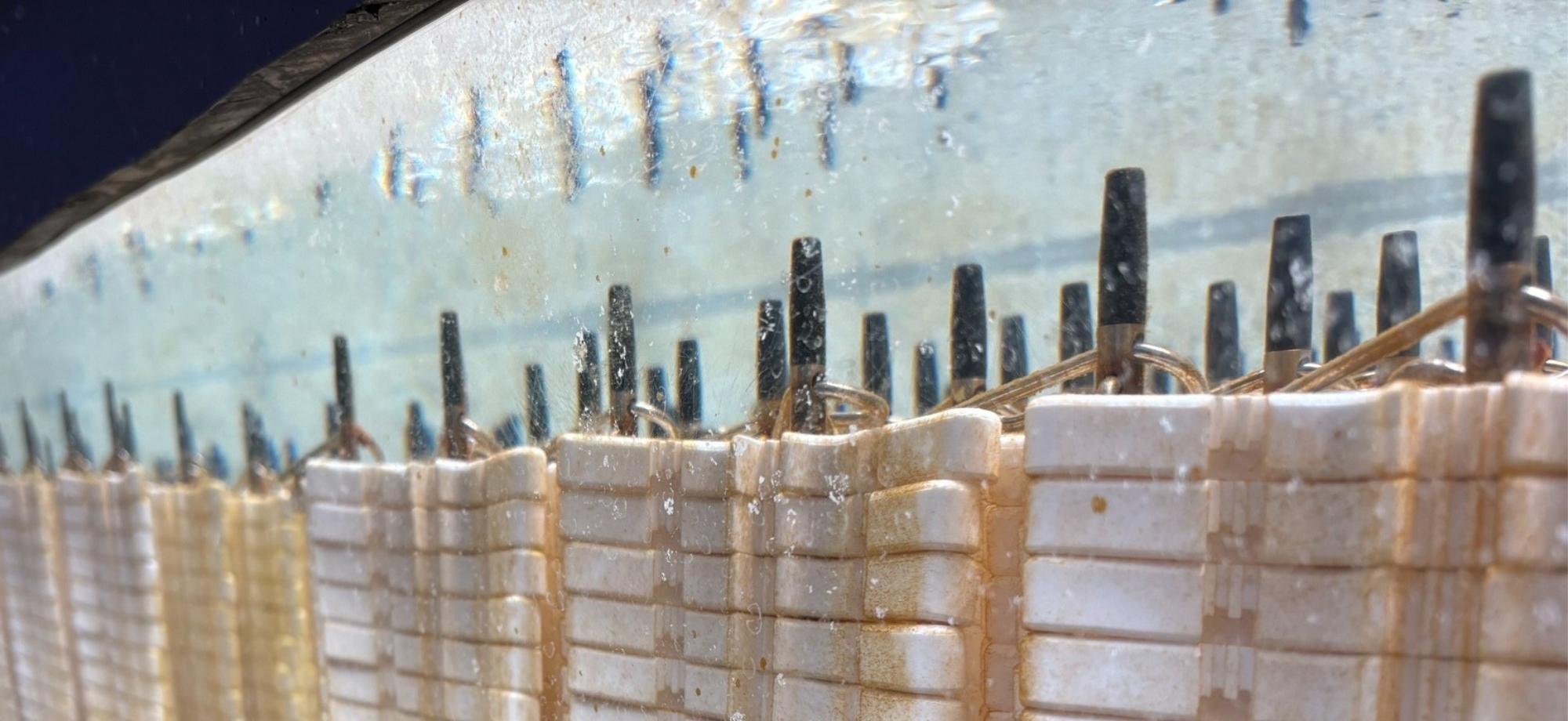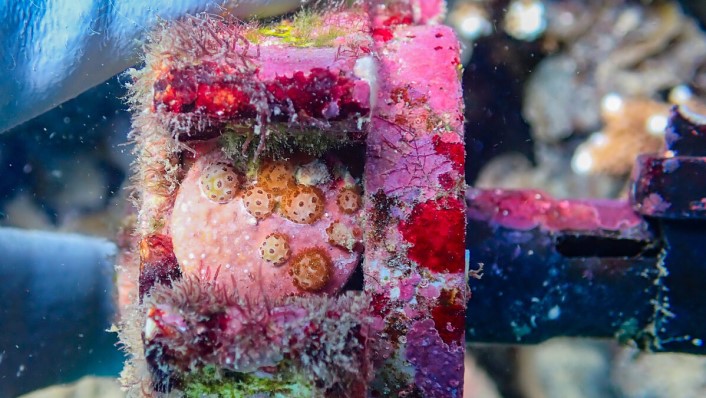One of the greatest challenges of reef restoration on the Great Barrier Reef is its vast size. AIMS and its partners are meeting this challenge by bringing together the latest science, innovative technologies, and people power.
The Pilot Deployments Program (PDP) is the operational testing phase of the Reef Restoration and Adaptation Program (RRAP). It is dedicated to understanding and improving the feasibility of using reef restoration tools at scale on the Great Barrier Reef.
The PDP aims to test the end-to-end delivery of millions of young corals, settled on large areas of reefs to help fast track their recovery. This will amplify the Reef’s own restorative phenomenon: mass coral spawning.
This three-year program is delivered by AIMS alongside RRAP partners, and funded by the Australian Government’s Reef Trust. The Great Barrier Reef Foundation Reef Restoration Fund also provides philanthropic funding.
The initial years of RRAP focused on the research and development of technologies and scientific knowledge required for reef restoration. The PDP explores how to put this into practice at scale, taking into account feasibility, safety and governance. Ultimately, the insights gained here will support the deployment (as required) of large-scale, integrated reef restoration and adaptation interventions.
Why do we need reef restoration?
Climate change is the greatest threat to reefs worldwide, and reducing emissions is critical to ensuring the future of coral reefs around the world.
But emissions’ reductions alone will not safeguard the Great Barrier Reef and coral reefs around the globe. Ocean warming to date has already been damaging, and further warming is locked in. Reefs’ natural recovery processes are now severely challenged.
Additional options are needed to give the Great Barrier Reef the best chance to survive and prosper in a warmer future, and to increase the window for global emissions reduction. Therefore, in tandem with global action on emissions and good local management, a new toolbox of scalable interventions to restore reefs are required.
How does the PDP work?
As the tools developed by RRAP become ready, they are transitioned into the PDP for real-world trials. Lessons learned from these field trials help the RRAP research teams to refine, adapt, or scale technologies. allowing continuous improvement and accelerating development.
Initially, two types of restoration interventions will undergo pilot deployment on the Reef. These are the seeding of coral larvae and the seeding of corals propagated by aquaculture. Both were selected for their technological readiness and modelling of their potential benefits for the Reef.
Slick Collection and Release (larval-based seeding)
Wild coral spawn are collected from the ocean surface at selected reefs during mass coral spawning events using hand-held spawn collectors and catchers. Collected coral spawn are transferred by small boats to larval rearing pools.
Once the larvae are fully developed and ready to settle, they are transferred and delivered directly onto a selected area of reef. Operators can release the larvae all at once, known as a larval cloud delivery, or deploy them using seeding devices.
By harnessing wild coral spawn, the slick collection and release method improves the odds for coral larvae to develop into young corals in areas of reef that need help. The method also takes advantage of local species and genetic diversity and is relatively low cost.
The larval rearing pools are used in collaboration with Prof. Peter Harrison (Southern Cross University) and Secore International.
Conservation Aquaculture (rearing corals)
Over five years, scientists developed and trialled aquaculture systems with the capacity to produce millions of coral larvae and young corals every year. This can be done using existing land-based aquaculture facilities or as a ‘containerised’ unit, known as ReefSeed, which can be used more remotely.
The process begins with the collection of wild coral colonies (the parent corals), which are then temporarily transferred to land-based facilities. These corals are spawned and larvae reared in semi-automatic conservation aquaculture designed to improve health and resilience.
Young corals are settled onto modular tiles which are inserted into ceramic coral seeding devices. These devices are transported to vessels and deployed from the surface to their parent reef cluster (the parent corals are also returned to their home reef).
Conservation aquaculture is still in its infancy, but can produce many more corals that it did just a few years ago, at a fraction of the cost. The advantage of this method is that it supports the breeding and deployment of corals with higher heat tolerance, either through selective breeding or inoculation of heat-evolved symbionts. Corals bred for higher heat tolerance using these methods are not currently part of the pilot deployments.
Monitoring pilot deployments
Monitoring of the young corals after deployments is essential to understand the efficacy or the methods, and inform future iterations, Monitoring of sites will be conducted at multiple scales, and be carried out by science teams, industry and participating Traditional Owner groups.
Manual and tech-based monitoring approaches such as ReefScan and photogrammetry will be used across the sites, with some surveys continuing after the three-year program concludes.
Device locations are geotagged and monitored in 6-month and 1-year intervals to measure retention, coral growth and survival. This data will help improve device design and inform coral resilience research.
People power behind the PDP
A key practical part of scaling up reef restoration is to empower local people and industries, by building skills, capacity and partnerships.
One way to do this is by providing training in the advanced skills of reef restoration, with the intention that these skills will become increasingly valuable as reef restoration activities expand in future.
In 2025, the PDP established a Panel of Providers to deliver specific services and solutions over a three-year period. This includes coral seeding, monitoring and data collection. The Panel of Providers has Traditional Owner representatives, as well as tourism and commercial reef operators, and members of the coral collection and aquarist industry.
Traditional Owners
Traditional Owners hold important cultural and spiritual connections to Country, including sea Country on the Great Barrier Reef. These connections power deep knowledge and care for the Reef, and inherent rights and responsibility for its future.
The Pilot Deployments Program works closely with indigenous communities. Free, prior and informed consent is obtained through Traditional Owner engagement before any Pilot deployment activities.
For example, the AIMS-led Indigenous Futures Project works in partnership with Indigenous Ranger groups and PDP. Its goal is to empower Traditional Owners to lead in caring for sea Country through reef restoration techniques. A pilot group of Indigenous Rangers are being trained in advanced skills for reef interventions, enabling them to lead these activities within their ranger groups for the future of sea Country when and where required.
Technological advances for PDP
Several technologies have been pioneered and refined for use in PDP operations. Technological advances will continue based on feedback from early PDP data. Some examples of technologies which have already emerged include:
Coral seeding devices
One way to ‘seed’ corals back onto reefs is to place newly settled corals onto specially designed and manufactured devices (which we call seeding devices) and then deploy the devices onto a reef.
Seeding devices are used in reef restoration worldwide. Our seeding device designs are evolving to suit the specific needs of large-scale reef restoration on the Great Barrier Reef.
The latest designs incorporate modularity, multidimensionality, and features for improved retention and coral protection, as well as ensuring compatibility with automated production processes and robotics. They are designed so that they can be coated with antifoulants or probiotics that can boost young coral growth.
Coral larval pools
The coral larval pool technique, sometimes called Coral IVF, involves collecting coral gametes during mass spawning events, fertilising them to produce larvae, and culturing these larvae in controlled environments, before releasing them back onto their source reefs.
The controlled environments resemble inflatable pools floating on the ocean surface. These larval rearing pools are used in collaboration with Prof. Peter Harrison (Southern Cross University) and Secore International.
Deployment Guidance System
The DGS integrates AI and marine robotics with expert ecological knowledge to select suitable sites for coral deployments. It first charts a coverage map across the chosen site
With the aid of an autopilot, it surveys the site in real-time using cameras with AI. Coral devices are surface deployed, with GPS marking their locations to help ongoing monitoring.
Uncrewed and crewed device dispensing machines are also being developed, that can feed-in stacks of devices and then dispense them as guided by the DGS.
Management
The innovative approaches being developed within the RRAP and the Pilot Deployments Program contribute to a toolbox of options for future management needs. It is critical they are developed with this end-use in mind.
Pilot Deployments Program activities align with Reef protection objectives, regulations and permitting processes from the Reef Authority and the Queensland Department of Environment, Tourism, Science and innovation (DETSI).
AIMS collaborates with both regulatory bodies to codesign and implement the trials, and continue R&D.
The Pilot Deployments Program is funded by the Australian Government’s Reef Trust, and led by the Australian Institute of Marine Science. It is part of the Reef Restoration and Adaptation Program, funded by the partnership between the Reef Trust and the Great Barrier Reef Foundation.








